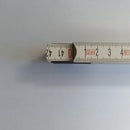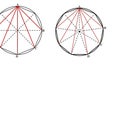Introduction: Draw a Regular Octagon Using a Rigid Square Template, a Straight Edge and a Pencil or Pen.
The problem posed in the title of this Instructables can be regarded as a problem in recreational mathematics. There are many sites on the internet describing how to construct a regular octagon inside a square with four of the octagon’s sides lying on the sides of the square. Most of these constructions require the use of a compass and a ruler resulting in an octagon whose area is less than that of the square into which the octagon is inserted. (The area of the octagon is 2 (√2 – 1) times the area of the square, which is approximately eight tenths the area of the square.) The problem stated in the title of this Instructables can be regarded as an extension to these latter methods resulting in an octagon whose area is larger than that of the square. The only requirements for this method are:
- a rigid square, which acts as a template;
- a straight edge; (unlike a ruler, a straight edge does not have markings on it for measurement; a ruler can be used as a straight edge but not vice versa);
- a piece of paper onto which the octagon is drawn;
- a pencil or pen.
Step 1: Construct a Square Grid
Use the square template to construct a two by two square grid.
Step 2: Place the First Mark on the Square Grid to Indicate One of the Corners of the Octagon
Place the corner of the square template on one of the outer corners of the square grid and align the opposite corner of the template so it lies on one of the outer sides of the square grid. Then place a mark on that side of the square grid where the opposite corner of the template meets the outer side on the square grid.
Step 3: Marking the Remaining Corners of the Octagon
Repeat the previous operation using the same corner of the square grid, but now having the opposite corner of the template lying on the outer side of the square grid at right angles to the side which was just marked. Repeat Step 2 and this step for each of the remaining three outer corners of the square grid.
Step 4: Drawing the Octagon
Draw lines between the pairs of the marks on adjacent outer sides of the square grid closest to the outer corners of the square grid.
The four lines joining adjacent outer sides of the square grid as well as the four lines on the outer sides of the square grid between the two marks closest to the outer corners form a regular octahedron whose area is 8 (√2 – 1) times the area of the square template, which is approximately three times the area of the template.
Step 5: Drawing Larger Octagons
Larger octagons can be drawn using this approach by first constructing a larger square grid using the square template. The only restriction is that the number of squares, n, on the outer sides of the square grid is an even number.
For an n by n square grid, use the square template n2 times to construct the grid. Then using the length of the diagonal of the square template place two marks on each of the outer sides of the square grid so that the distance between each outer corner of the square grid and each of the marks on the outer side of the square grid is equal to n / 2 times the length of the diagonal of the square template. Finally, draw lines between the pairs of marks on adjacent outer sides of the square grid that are closest to the outer corners of the square grid.
The above diagram provides an example for a 6 by 6 square grid.
Step 6: Drawing an Octagon When the Number of Squares Along the Sides of a Square Grid Is an Odd Number.
Given a square grid with an odd number, n, of squares of area a2 on each outer side of the grid, it is not possible, using a rigid square template whose side length is a, to mark off points on each outer side of the grid whose total length is equal to n / 2 times the length of the diagonal of the square template. This follows since only lengths of multiples of a√2 can be used as a means for marking off distances using the diagonal of the square template.
However, a grid with an odd number, n, of squares on each side of the grid can be constructed by following these steps:
- construct a 2n by 2n square grid containing (2n)2 squares;
- construct the octagon as described above;
- delete all the odd horizontal and vertical lines on the 2n by 2n grid leaving an n by n grid where n is an odd number; the first horizontal and vertical lines are the horizontal and vertical lines belonging to the two lines of one of the corner squares of the grid which are not on the outer sides of the grid.
Using the 6 by 6 square grid in Step 5 and colouring the even lines in this grid blue, results in the diagram shown in this step. This diagram shows a regular octagon (red) inside a blue 3 by 3 square grid.
One feature of the grid in the above diagram relates to an Instructables published in 2013. The author of this Instructables describes a simple way to draw an octagon in a square which involves:
- dividing the sides of the square into thirds;
- placing marks on the sides of the square to indicate the points of division;
- constructing a 3 by 3 square grid;
- drawing lines between the pairs of marks nearest to the adjacent outer corners of the square grid.
The above diagram shows that the corners of a regular octagon do not coincide with the intersection of the blue lines with the outer sides of the grid. While the method described in the 2013 Instructables article results in an octagon, this octagon is not a regular octagon. To make a regular octagon from the octagon described in the 2013 Instructables article, both pairs of marks on each of the outer sides of the square grid in the 2013 Instructables article need to be shifted by about 12% towards the outer corners of the square grid before drawing lines between the nearest pairs of the newly created marks nearest to adjacent outer corners on the outer sides of the square grid.
Step 7: Show That All Sides of the Octagon Using the Method Described in Steps 1-5 Are Equal
The above diagram shows some of the vertices on the square and the octagon with labels placed on them.
To prove that a regular octagon is obtained using the method outlined in Steps 1-5, we have to show that the length of BC in the above diagram is equal to that of CE. The equality of the lengths of the remaining sides follows from the repetitive operations applied in the method. The following proof is for an n by n grid where a is the side length of the square template.
Length of AD = na
Length of AC = length of BD = (na √2) / 2 = na / √2
Length of CD = length of AD – length of AC = na - na / √2 = na (2 – √2) / 2 = length of AB = length of DE
Length of BC = length of AC – length of AB = na √2 / 2 – na (2 – √2) / 2 = na (√2 – 1)
Using Pythagoras’ theorem, length of CE = (length of CD) × √2= na (√2 – 1)
Thus, the length of BC = length of CE.
Step 8: Ratio of Areas of the Regular Octagon to That of the Square Template
Again, using an n by n square grid and the diagram in the previous step,the area of the triangle CDE = (length of CD) × (length of DE) / 2 = [na (2 – √2)] 2 / 8 = [(na)2 (3 - 2√2)] / 4.
The area of the octagon = area of n by n square grid - 4 × (area of triangle CDE) = 2 (na)2 (√2 - 1).
The area of the square template is a2.
The ratio of the area of the octagon to that of the square template = 2 n2 (√2 - 1).
Step 9: Convert a Non-rectangular Octagon Into a Regular Octagon Using the Method Described in the 2013 Instructables Article
In this final step we return to the method described in the 2013 Instructables. We derive an expression for the amount by which the marks on each outer side of the square grid, as described in the 2013 Instructables article, need to be moved to create a regular octagon from the non-regular octagon. If the distance between each of the two marks on each outer side of the square grid in the 2013 Instructables is of length a, then these marks must be shifted (see diagram in Step 6) so as to reduce the lengths of the distances between the outer corners of the square grid and the marks nearest them on the outer sides of the square grid. The length, a, from each corner of the square must be shortened so its length is equal to the length of AB in the diagram in Step 7 when n = 3. The difference between these lengths is a - (length of AB) =
a - {[3a(2 – √2)] / 2} = a(3√2 - 4) / 2 = a(3/√2 - 2).
So, each of the marks that would touch the grid lines in Step 6 (if using the method described in the 2013 Instructables) needs to be moved a distance of 100 × (3/√2 - 2)% towards the corners on the outer sides of the grid, that is approximately 12%.













